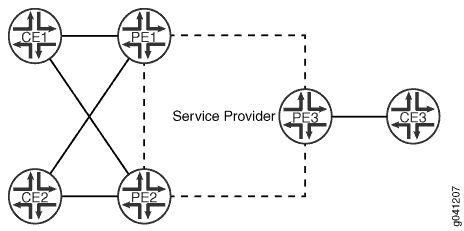peer-active (VPLS Multihoming for FEC 129)
Syntax
peer-active;
Hierarchy Level
[edit logical-systems logical-system-name routing-instances instance-name protocols vpls multi-homing], [edit logical-systems logical-system-name routing-instances instance-name protocols vpls multi-homing site site-name], [edit routing-instances instance-name protocols vpls multi-homing], [edit routing-instances instance-name protocols vpls multi-homing site site-name]
Description
Keep customer edge (CE) interfaces in the up state when all BGP peers go down.
In the VPLS documentation, the word router in terms such as PE router is used to refer to any device that provides routing functions.
Consider a scenario in which two provider edge (PE) routers are sharing two multihomed sites under one routing instance, with two CE devices, CE1 and CE2.

If the BGP peering session drops between Router PE1 and Router PE2, each one would consider itself to be the designated forwarder (DF) for Device CE1 and Device CE2. This creates a loop through the two CE devices, in which traffic loops from one CE device to the other then back to the first.
Junos OS overcomes this scenario by dropping all multihomed CE interface traffic on all multihoming PE routers when the BGP session drops between the PE routers. This functionality is enabled by default for all sites in a routing instance.
The peer-active statement disables the default functionality,
so that PE routers keep their multihomed CE interfaces in the up state,
even though the BGP peering session is down.
If you configure this statement in the multi-homing hierarchy, the default functionality is disabled for all sites.
If you configure this statement for a site, the default functionality
is disabled only for that particular site.
Default
If you omit this statement, Junos OS drops all multihomed CE interface traffic on all multihoming PE routers when the BGP session drops between the PE routers.
Required Privilege Level
routing—To view this statement in the configuration.
routing-control—To add this statement to the configuration.
Release Information
Statement introduced in Junos OS Release 12.3.
